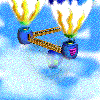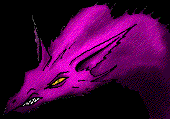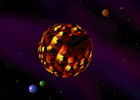


 |  |  |
|---|
| The Assassins' Guild was one of the major powers in Darkside, and due to its location in Rephidim, had considerable influence over matters of assassination all over Sinai. It was best known for its intermediaries, the Faceless Men, who would handle contracts for its members, and for its "Maestro" assassins - near legendary killers with flamboyant trappings and trademark methods of death-dealing. For a time, the Assassins' Guild rivaled the Thieves' Guild and the crime lord Faraon the Friend in the power structure of Darkside, until Faraon the Friend had the Assassins' Guild wiped out under cover of major rioting. The Old Well, once a symbolic meeting place for those who sought the business of the Guild, was subsequently sealed by Faraon's forces. | ||
|---|---|---|
| ||
| A major river of the continent of Ur, running along the western borders of the Hekoye Nation and the Forbidden Zone of Shabar, ending in the Stygian Sea. This river's name literally means "strange looking", and is tied to the Hekoye name for Shabar. | ||
 "The Audit" refers to a part of Rephidim Temple known by various names, but basically they are the General Accounting Office, responsible for all things financial. Of the three major branches of the Temple, the Audit falls under the "Operations Branch". "The Audit" refers to a part of Rephidim Temple known by various names, but basically they are the General Accounting Office, responsible for all things financial. Of the three major branches of the Temple, the Audit falls under the "Operations Branch"."The Audit" also refers to the process that is feared even by others of the Temple ... and which gives this department of the Temple considerable influence in the affairs that would normally fall under the jurisdictions of the other departments. Auditors are the most visibly wealthy members of the Temple, as a group, wearing robes of white and gold, with "traditional" trappings of gold and other precious materials. Their leader is the Quartermaster Supreme, who answers in turn to the Bridge. | ||
| ||
 Refers to both the capitol city of Ashdod, as well as the great tower which dominates the cityscape. This city, dominated by the bat-like Eeee, is a major center of trade and political power in Ashdod on the continent of Ur. It is built in a wide valley in the Golan Mountains, a short flight from the ocean. Refers to both the capitol city of Ashdod, as well as the great tower which dominates the cityscape. This city, dominated by the bat-like Eeee, is a major center of trade and political power in Ashdod on the continent of Ur. It is built in a wide valley in the Golan Mountains, a short flight from the ocean.The city is truly ancient, records indicating that it was founded millenia ago, and new buildings have been repeatedly built upon the ruins of others, to the point where the metropolis consists now of towering spires and ziggurats, interconnected by stone bridges and aqueducts to bear water from the mountain peaks. The largest structure by far is the Great Tower, Babel, which is forever under construction. It is a measure of a ruler's power how much he can add to the tower's girth and height, and over time it has expanded outward to consume older portions of the city. Officially, no one actually lives in the Tower. It is a structure of religious (and political) significance, and a statement of the power and age of the Ashdodite civilization. Many of the battles fought in Babel are between warring construction crew factions, over matters of building and resources to be used. Babel is sometimes known as the "City of Strife", for "gang wars" are commonplace, especially in the shadowed and ruinous "Streets Below" in the forgotten lower levels that have been built upon with each succeeding generation. For millenia, the ruler of Babel (and, by extension, the ruler of Ashdod, at least in title), was known as the Sabaoth, which means "Almighty". After the War of the Plaguebringers, in which Babel was soundly defeated during a raid on Rephidim, the Sabaoth's reign ended, and he was succeeded by the first High Prince of Babel, Boghaz bar Sabaoth. | ||
| ||
| (not commonly known outside of Babel and religious circles) Bael is one of many archaic names given to a creator god in the Babelite mythos -- referred to, but not by name, in the myth of the Birth of the Seven Sisters. Some time in Babel's early history, the pantheon of gods and goddesses was dominated by a creator/destroyer duality: Bael, Creator and Lord of the Sky, and Vael, Destroyer and Lady of the Earth. According to popular legend, the Seven Sisters were born of Bael and Vael, and rebelled, destroying their father and taking his power. Bael is still recognized in the Babelite pantheon, but as a "dead god", incapable of answering prayers. | ||
 The diminutive Aelfins of Aelfhem build airships that do not rely upon lighter-than-air gases, but instead upon hot air for buoyancy. While they do not suffer from the problems of combustible envelopes that most Sinai airships do, they have a limited range due to fuel requirements. Due to a long-standing conflict with some Eeee clans living in the mountains bordering Aelfhem, for a long time these craft were no longer made, but a recent cessation of the hostilities has allowed for their production once more. The diminutive Aelfins of Aelfhem build airships that do not rely upon lighter-than-air gases, but instead upon hot air for buoyancy. While they do not suffer from the problems of combustible envelopes that most Sinai airships do, they have a limited range due to fuel requirements. Due to a long-standing conflict with some Eeee clans living in the mountains bordering Aelfhem, for a long time these craft were no longer made, but a recent cessation of the hostilities has allowed for their production once more.
| ||
| ||
| (not common knowledge outside of Babel and religious circles) Means "harmony" or "peace" in Babelite. According to the myth of the Birth of the Seven Sisters, this was the former name of Blakat, Goddess of Conflict, before she and her sisters rebelled against and killed Bael, the creator god. | ||
| ||
| (obscure information outside of Ashdod, or religious circles) Although the exact "birth order" of the Seven Sisters is in question, Barada is traditionally held to be the youngest of the seven, though this doesn't exempt her from her fair share of bloodshed and mayhem. She is the matron of spies and seers, but also of those keeping secrets ... so she's also seen as a matron of thieves, at times, and she's also been strongly associated with wealth. Supplication is made to Barada in hopes that she will reveal secrets ... or make sure that they are kept. Businessmen often seek her blessing on their businesses ... or protection from thieves. Barada is a bit of a mischief-maker, sometimes choosing to reveal an otherwise perfectly-kept secret, just for the sake of stirring things up. Thus, when there is an unexplained "leak" of information, it is common to blame Barada's trouble-making. It is believed by many that the priestesses of Barada controlled a vast spy network that (for the most part) served the Sabaoth of Babel, mostly for the purpose of keeping tabs on the Houses of Babel and their activities. Mount Barada is also a location outside Babel, where there is a shrine built to the goddess of the same name. | ||
| ||
| (not common knowledge outside of Babel and religious circles) Translated as "Revelation". According to the myth of the Birth of the Seven Sisters, this was the former name of Barada, Goddess of Secrets, before she and her sisters rebelled against and slew Bael, the Creator God. | ||
| ||
 While there are no doubt many bazaars to be found on Sinai, the most famous and the most worthy of being called "The Bazaar" would be that of Rephidim. This is an unorganized sprawl of streetside booths and tents in an area of the city officially designated for "future expansion", but which sees use nonetheless as long as the proper bribes are made for officials to look the other way. Even so, the Temple generally has a presence in the form of guards to keep the peace ... as tempers flare often in the Bazaar, as a result of overly heated arguments over the value of a product, and accusations of trickery. For the most part, though, the Bazaar has a colorful, carnival atmosphere, and quite a share of street entertainers who work for a few shekels to be tossed in an upturned basket or hat. Even the noblesse can be seen at the Bazaar, to obtain rare and unusual imports, or just to see the sights. While there are no doubt many bazaars to be found on Sinai, the most famous and the most worthy of being called "The Bazaar" would be that of Rephidim. This is an unorganized sprawl of streetside booths and tents in an area of the city officially designated for "future expansion", but which sees use nonetheless as long as the proper bribes are made for officials to look the other way. Even so, the Temple generally has a presence in the form of guards to keep the peace ... as tempers flare often in the Bazaar, as a result of overly heated arguments over the value of a product, and accusations of trickery. For the most part, though, the Bazaar has a colorful, carnival atmosphere, and quite a share of street entertainers who work for a few shekels to be tossed in an upturned basket or hat. Even the noblesse can be seen at the Bazaar, to obtain rare and unusual imports, or just to see the sights. The Bazaar is best known for its everchanging nature, as booths tend to get put up or torn down daily, and a significant portion of the shopkeepers are the erratic and highly motivated Kavi. However, there are also a few more permanent storefronts, set up in old ruined buildings, serving as both residences and businesses, since there are no zoning laws to speak of in this area. The most noteworthy landmark of the Bazaar is the Clock Tower, visible from most any part of the area. The architecture of the Bazaar is greatly varied, a result of ages of being built and rebuilt, falling into ruin, then being modified to suit the needs of those who have reclaimed it in recent times for the purpose of making sales. There are buildings built upon buildings, and bridges that span streets and connect upper levels together, turning the Bazaar into a confusing maze in some quarters, best navigated by those with guides - or with wings. Many of the storefronts tend to "ghettoize", as evidenced by "Little Babel" - a cluster of stores and booths catering to Eeee clientele, which tends to move about the Bazaar any given day. | ||
| The "Beast Lands" are a wilderness of scrub and warpwood trees under the canopy of a Forbidden Zone in the Desolate Band of the Savan Territories. Of little importance in the greater scheme of things, they are not widely known of outside of the Savan, merely another Forbidden Zone for airship captains to avoid. But to those who live near, the Beast Lands are a place viewed with fear and dread, said to be an accursed ground where not only technology but magic becomes dangerous to try to use. Furthermore, it is said that children born in the Beast Lands will be born with the minds of savage beasts, lacking even the refinement of many nonsapient predators. Tales are told of cannibalistic, mindless savages that prey upon the unwary who wander too far into this vaguely defined zone ... and of cruel pirates who are bold enough to use this land to hide their base of operations. | ||
 Beasthounds are dog-equivalent pseudoreptiles, having scaly hides interspersed with sparse hairs, a ridge of sharp needle-like spines down their backs (making the act of petting them very hazardous), and muzzles that sport two triangle sets of sharp teeth. They are often employed as guard-dogs, though they are a bit too temperamental (and dangerous) to be used as true pets on any wide basis. Beasthounds are dog-equivalent pseudoreptiles, having scaly hides interspersed with sparse hairs, a ridge of sharp needle-like spines down their backs (making the act of petting them very hazardous), and muzzles that sport two triangle sets of sharp teeth. They are often employed as guard-dogs, though they are a bit too temperamental (and dangerous) to be used as true pets on any wide basis.
| ||
| ||
 Behemoth is the ninth and last known planet of the solar system, and also the largest. It appears to be mostly orange, though it requires powerful telescopic equipment to have a fair chance at even seeing it. It has several moons, and was long believed to be made of solid rock. It is strongly associated with the element of Earth and hence is of special importance to the Sphere of Earth (Earth, Sphere of) of the College Esoterica. Behemoth is the ninth and last known planet of the solar system, and also the largest. It appears to be mostly orange, though it requires powerful telescopic equipment to have a fair chance at even seeing it. It has several moons, and was long believed to be made of solid rock. It is strongly associated with the element of Earth and hence is of special importance to the Sphere of Earth (Earth, Sphere of) of the College Esoterica. Access has been made possible by the Gateway Tower, and scouts have reported that Behemoth is actually a gaseous giant surrounded by a sparse "cage" formed by a network of mind-bogglingly long tunnels fashioned of stone and Sifran crystal. The tunnels themselves somehow support an atmosphere and gravity comparable to that of the surface of Sinai. Levels of Quantum Uncertainty are such that neither magic nor sophisticated technology is known to work here. In the Olympian Pantheon, Behemoth is also the name of a god of earth, the mountains, of metal-working, and of strength, depicted as a huge and muscular Kattha. | ||
| Berryswort tea is a popular non-alcoholic "wake-up" drink in Ashdod, especially among fruit-bat Eeee. The best blends come from Saskanar, though other varities are cultivated elsewhere in Ashdod, and to a lesser degree on Sinai at large. |
| Home Page |
Player Guide |
Log Library |
Recent Logs |
|---|---|---|---|
| Encyclopedia |
Dramatis Personae |
Art Gallery |
Moz Ezley Asylum |